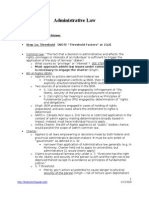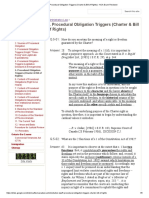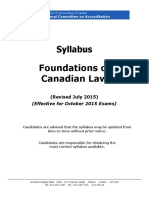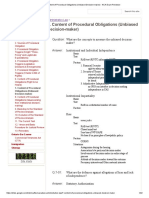NCA Constitution Law POGG
NCA Constitution Law POGG
Uploaded by
Jag MallaCopyright:
Available Formats
NCA Constitution Law POGG
NCA Constitution Law POGG
Uploaded by
Jag MallaOriginal Description:
Original Title
Copyright
Available Formats
Share this document
Did you find this document useful?
Is this content inappropriate?
Copyright:
Available Formats
NCA Constitution Law POGG
NCA Constitution Law POGG
Uploaded by
Jag MallaCopyright:
Available Formats
Page | 1
PEACE, ORDER AND GOOD GOVERNMENT CHAPTER
-17
RESIDUARY
NATURE
OF
----------------------------------------------------------------------------2
POWER-
GAP BRANCH
HISTORY
ON
NATIONAL
-------------------------------------------------------------3
CONCERN
BRANCH
PRESENT SITUATION:- Russell case
DEFINITION
OF
NATIONAL
-----------------------------------------------------------4
1.
Nationwide importance
2.
Geographic Dimension
3.
Provincial Inability Test:
4.
Distinctness (unique not common in provinces)
CONCERN
5.
NEWNESS
-----------------------------------------------------------------------------------------------5
EMERGENCY BRANCH
CONCLUSION:
Page | 2
PEACE, ORDER AND GOOD GOVERNMENT - Chapter -17
RESIDUARY NATURE OF POWER
Section 91 of Constitution Act, 1867 gives federal parliament the power to
make laws for the Peace, Order and Good Government, the matters which
doesnt come with in the provincial heads, will fall under the federal power.
In the democratic government it was designed to create stronger central
government. But section 92 (13) Property and civil rights of the province
and 92(16) Matters merely of local and private nature in the province are
the sweeping heads of province, because most of the matters being covered
under these heads or it can be describes as an actual residuary power in the
hands of the province.
OConnor Report (1939) refused to agree with the POGG as a residuary
power, it was described in the report that enumerated heads of federal
power are merely the examples of the POGG, they are listed for the greater
certainty.
However, I disagree with the view of OConner report, my view is similar to P.
Hogg that it is clear from the opening words of the of section 91 that
enumerated heads are not the examples of the POGG, because if these
topics are considered to be merely examples then the topics given under
federal power (e.g. Trade and Commerce, Banking, Bill of exchange and
Promissory note, Copyright, Marriage and Divorce) would probably fall under
the section 92(13) Property and civil right of the province.
It was the historical necessity of describing these heads under the section
91, for limiting the broad scope of S.92(13).
Another reason for not agreeing with the OConner report, because courts
under the practice do not consider the enumerated head as merely
examples. These heads to be considered as exclusive power of central
government.
GAP BRANCH
Gap branch covers those cases and fills those gaps where a reference was
made to one aspect of subject matter and there is no mention of the other
Page | 3
aspect of the same subject matter. Under the POGG, gap branch is the way
to fill the gap between the distribution of powers between provincial heads
and federal heads, there are the few gaps in distributing the powers between
and province and federal. e.g. section 92(11) empowers the provincial
legislature to make laws in relation to incorporation of companies with
provincial object. Question arises what about those companies who as object
to work in more than one state, the gap is covered under the POGG power.
Another e.g. Section 132 of constitution act 1867 gives power to federal
parliament to enact the laws for the obligations arising out as a part of
British Empire and treaties signed by the British Empire on the behalf of
Canada. But Section 132 is silent about the treaties signed by the Canada by
its own as an international person. Even it does not mention anywhere in S.
91 or S. 92. The gap is covered under the POGG power.
HISTORY ON NATIONAL CONCERN BRANCH
Russell V. The Queen (1882) Privy.C. upheld (by Sir Montague Smith) the
statute (Canada Temperance Act- for the control of excess consumption of
liquor) on the basis that it did not fall within any of the provincial heads of
legislature.
Above Russell case later explained by Privy Council in Local Prohibition
Case (1896) by Lord Watson and first time National Concern Branch defined
in the definition of POGG that no doubt some matters are local and provincial
in nature, which affects the whole body politic of dominion. Great caution
must be observed by Canadian Parliament before passing the law and the
matter ceasing to be local or provincial and become and national concern.
Although Russell Case was explained in the Local Prohibition Case, but the
decision of local prohibition case was different from the Russell case, court
upheld the provincial statute (Local-Option Temperance Scheme, which was
similar to federal law) under the property and the civil rights of the province
S. 92(13). This time court also established the double aspect doctrine, which
allows the both governments to enact the same law in the same field.
Viscount Haldane came into the Privy Council in 1911 and died in 1928,
under the tenure of Viscount Haldane Privy Council ignored the National
Dimension dictum, and insisted only the emergency branch of the POGG
power.
PRESENT SITUATION: Russell case was again challenged in A.-G. Ont. V.
Canada Temperance Act (1946) two arguments was presented
Page | 4
1. Whether the Russell case was wrongly decided? OR
2. If the Russell Case was based on the emergency, the alleged emergency
of drunkenness had now passed away.
Court didnt answer the questions and Privy Council through Viscount Simon
refused to overrule the Russell case and said its been 60 years and case is
firmly rooted in the Constitution on Canada and held that Russell was not
decided on the basis of Emergency and POGG is not only confined to
emergencies. Viscount Simon gave the new test: that the real subject matter
goes beyond the local and provincial interest and become the concern of
dominion as whole.
Jonannesson V. West St. Paul (1952) S.C. held that aeronautics satisfied the
national concern test.
Munro V. National Capital Commission (1966) Quebec and Ontario became
unsuccessful in settling the national capital region area trough
cooperation and S.C. held that National Capital region satisfied the national
concern test.
R. V. Crown Zellerbach (1988) S.C. upheld the Federal Ocean Dumping Act
and marine pollution satisfied the National concern test, because it effects
the international waters and it is the matter of Canada as whole.
Ontario Hydro V. Ontario (1993) S.C. upheld the federal jurisdiction over
atomic energy under Federal Atomic Energy Control Act under S.92(10)(c)
and also the production, use and application of atomic energy is the matter
of national concern.
A)
DEFINITION OF NATIONAL CONCERN
Q. When does the subject matter of legislation satisfies the national
concern test?
1.
Nationwide importance of the subject of the legislation, but the
argument raised against only nationwide importance, because some
nationwide importance matter i.e. Law of contract, property, education, etc.
all are within the provincial jurisdiction.
2.
Geographic Dimension can also be a factor, but cannot be a sole
factor for satisfying the national concern branch. There are some cases
where uniform laws are not desired, but its essential, because its beyond
the provincial ability to deal with it.
Page | 5
3.
Provincial Inability Test: Failure of one province to take preventive
measures. E.g. In Munro case failure of Quebec and Ontario to cooperate on
National Region matter.
4.
Distinctness (unique not common in provinces)
Only distinctness is not sufficient to satisfy, but provincial inability test is
required the matter to be admitted under the national concern branch of
POGG, otherwise the matter will fall under the provincial power of 92(13) or
92(16).
Anti-Inflation Reference (1976) S.C. upheld the federal wage and price
control under the Emergency Branch of POGG. But Beetz J. denied on the
national concern branch, because wages and price control is too broad topic
and under the national concern branch and matter must be a distinct for
passing under the national concern branch . This opinion was supported by
the majority and court upheld the federal wage and price control under the
emergency branch.
5.
NEWNESS
The matters which did not exist during the confederation and now they
cannot be put labeled under the provincial or federal power and the matter is
clearly new in nature, will be dealt as a new problem and comes under the
POGG power of central government. In The Queen V. Hauser(1979) Due to
the new subject matter S.C. held the federal Narcotic Control Act as a valid
exercise of POGG power. Later on in 2003 R. V. Malmo-Levine S.C. held the
possession of marihuana was a valid law power of criminal law and overruled
the decision of Hauser case.
Because the matter of drugs may also come under the criminal power of the
Central government, at that time, federal power to prosecute under the
criminal law was in doubt, thats why the courts tendency to move the laws
into another category.
Conclusion of newness: It is concluded that newness is irrelevant and
unhelpful in determining the content of residuary power.
Matter like Aeronautics, Atomic energy and National Capital region does not
come with in the any enumerated heads of power and covered under the
POGG power.
Page | 6
EMERGENCY BRANCH
Viscount Haldane came into the privy council in 1911 and died in 1928,
under the tenure of Viscount Haldane privy council ignored the National
Dimension dictum, and insisted only the emergency branch of the POGG
power.
In Toronto Electric Commissioner V. Snider (1925) Privy Council through
Viscount Haldane said that POGG power was available only in the cases
arising out of some extraordinary peril to the national life of Canada, such as
the cases arising out of a war.
Anti-Inflation Reference (1976) After the Act had been in force for six
months, the federal government referred the act to the supreme court of
Canada for a decision as to its constitutionality and Court upheld the act as
an emergency measure.
Temporary character of law is the limitation on the federal emergency
power. Privy Council struck down most of the new deal legislation due to the
permanent nature of the new deal measures.
War, Apprehended insurrection, Inflation,
CONCLUSION: In order to classify the law, one will have a look at exclusive
lists of 91 and 92 and then proceed to different branches of POGG (Gap,
National and Emergency Branch).
You might also like
- Con Law - NCA Summary - HoggDocument76 pagesCon Law - NCA Summary - HoggJed_Friedman_8744No ratings yet
- Practice Exam AnswersDocument8 pagesPractice Exam AnswersDavid Terner100% (1)
- Nca Practice Exam Prof RespDocument7 pagesNca Practice Exam Prof RespDavejot SandhuNo ratings yet
- NCA Criminal Law NotesDocument58 pagesNCA Criminal Law Notesukrolandas100% (1)
- NCA Constitution Law OUTLINEDocument37 pagesNCA Constitution Law OUTLINEbanjo99100% (3)
- NCA Exam Constitutional Law Outline Jan 2019Document65 pagesNCA Exam Constitutional Law Outline Jan 2019David Terner100% (1)
- Lesson 5 Globalization and Asia Pacific and South AsiaDocument98 pagesLesson 5 Globalization and Asia Pacific and South AsiaRachel Renti Cruz88% (17)
- Administrative Management TheoryDocument15 pagesAdministrative Management TheoryNazLubna100% (2)
- NCA Sample Exam Professional Responsibility 2009Document6 pagesNCA Sample Exam Professional Responsibility 2009Siddhant ShahNo ratings yet
- NCA Exam FoundationDocument3 pagesNCA Exam FoundationNCAStudent50% (2)
- Admin Final NotesDocument16 pagesAdmin Final NotesErnest WooNo ratings yet
- Foundations of Law NCA SummaryDocument22 pagesFoundations of Law NCA SummaryErnest Woo100% (5)
- NCA Administrative Law OutlineDocument145 pagesNCA Administrative Law Outlineesquire1010100% (3)
- NCA Criminal Law NotesDocument62 pagesNCA Criminal Law Notesukrolandas100% (3)
- Payroll Discrepancy FormDocument1 pagePayroll Discrepancy FormJag MallaNo ratings yet
- Critically Discuss The Extent of Directors Duties and The Changes Made by The Companies Act 2006Document14 pagesCritically Discuss The Extent of Directors Duties and The Changes Made by The Companies Act 2006Lingru WenNo ratings yet
- NCA Con Law Review OutlineDocument8 pagesNCA Con Law Review Outlinesarasavesq100% (1)
- Constitutional Law NCA SummaryDocument59 pagesConstitutional Law NCA SummaryPedro David Pérez100% (1)
- NCA Constitutional Law Aug 2013Document108 pagesNCA Constitutional Law Aug 2013MMG100% (1)
- NCA Con Law GUIDE 2012.pagesDocument11 pagesNCA Con Law GUIDE 2012.pagesAmy MacAlpineNo ratings yet
- Legal Theory: Craik: Chapter 2 PP 7-47Document51 pagesLegal Theory: Craik: Chapter 2 PP 7-47Tiffany100% (1)
- Foundation (NCA) Sample PAGES 1Document3 pagesFoundation (NCA) Sample PAGES 1ElyzaNo ratings yet
- Procedural Obligation Triggers (Charter & Bill of Rights) - NCA Exam ReviewerDocument5 pagesProcedural Obligation Triggers (Charter & Bill of Rights) - NCA Exam ReviewerrazavimhasanNo ratings yet
- NCA Criminal Law Oct 2013Document146 pagesNCA Criminal Law Oct 2013MMG100% (2)
- NCA Criminal OutlineDocument16 pagesNCA Criminal OutlinegmfbruniNo ratings yet
- NCA Criminal LawDocument34 pagesNCA Criminal LawKusumNo ratings yet
- Nca Professional Responsibility (Part 4)Document19 pagesNca Professional Responsibility (Part 4)bebeGloNo ratings yet
- Administrative Law - NCA Summary (Updated)Document24 pagesAdministrative Law - NCA Summary (Updated)Jed_Friedman_874467% (3)
- NCA Constitution 2014 FINALDocument251 pagesNCA Constitution 2014 FINALlt0922875% (4)
- 2016 NCA Foundations of Canadian Law SyllabusDocument9 pages2016 NCA Foundations of Canadian Law SyllabusumarzulqarnainNo ratings yet
- NCA Criminal LawDocument25 pagesNCA Criminal LawKusumNo ratings yet
- Syllabus: Canadian Administrative LawDocument15 pagesSyllabus: Canadian Administrative LawVijaiNo ratings yet
- Notes For Canada Cons Law Final Nca ExamsDocument54 pagesNotes For Canada Cons Law Final Nca Examsk gandhi100% (2)
- Nca Syllabus Admin Revisedfeb2014Document12 pagesNca Syllabus Admin Revisedfeb2014mike12345mikeNo ratings yet
- Class Notes All Lectures CombinedDocument80 pagesClass Notes All Lectures CombinedJuliana MirkovicNo ratings yet
- NCA Criminal Law Rules Only August 2012Document7 pagesNCA Criminal Law Rules Only August 2012sarasavesqNo ratings yet
- NCA Administrative Law Aug 2013 Part IIDocument85 pagesNCA Administrative Law Aug 2013 Part IIMMG100% (3)
- Admin Cases For NCA Exam 2015Document4 pagesAdmin Cases For NCA Exam 2015NonameENo ratings yet
- NCA Admin Law OutlineDocument51 pagesNCA Admin Law OutlineYifei He100% (1)
- NCA Canadian Foundations Aug 2013Document63 pagesNCA Canadian Foundations Aug 2013MMGNo ratings yet
- Con Law Final - NCA ExamsDocument64 pagesCon Law Final - NCA ExamsJed_Friedman_874480% (15)
- Foundation LawDocument185 pagesFoundation LawmanubatishNo ratings yet
- Canadian Public and Constitutional Law 6847A Class 3 SlidesDocument42 pagesCanadian Public and Constitutional Law 6847A Class 3 Slides7pzd897x67No ratings yet
- NCA Foundations of Law Outline 2012Document40 pagesNCA Foundations of Law Outline 2012sarasavesq100% (6)
- Admin Template (Not An Nca Summary)Document40 pagesAdmin Template (Not An Nca Summary)Laura KhalilNo ratings yet
- Constutional Law SummaryDocument64 pagesConstutional Law SummaryBishop_HarrisLawyersNo ratings yet
- Constitutional Law NCADocument86 pagesConstitutional Law NCAmehtavar67% (3)
- Administrative Law Framework GuideDocument34 pagesAdministrative Law Framework GuideKeiara PatherNo ratings yet
- NCA Crim Procedure Outline August 2012Document20 pagesNCA Crim Procedure Outline August 2012sarasavesqNo ratings yet
- Content of Procedural Obligations (Unbiased Decision-Maker) - NCA Exam ReviewerDocument22 pagesContent of Procedural Obligations (Unbiased Decision-Maker) - NCA Exam ReviewerrazavimhasanNo ratings yet
- NCA 2023 Exam Sched v2 3Document7 pagesNCA 2023 Exam Sched v2 3sahil sharmaNo ratings yet
- 2 PR Extensive Summary Canadian Professional ResponsibilityDocument83 pages2 PR Extensive Summary Canadian Professional ResponsibilityBob StevensonNo ratings yet
- Chapter 1: Canadian Professional ResponsibilityDocument11 pagesChapter 1: Canadian Professional ResponsibilityRob Korzecki100% (1)
- Breeze - Law100 - Greshner - 1l - MidtermDocument18 pagesBreeze - Law100 - Greshner - 1l - MidtermJjjjmmmmNo ratings yet
- Recent Cases - Constitutional Law. Tax Immunity of State Governmen PDFDocument4 pagesRecent Cases - Constitutional Law. Tax Immunity of State Governmen PDFPriyaNo ratings yet
- Pata V AgDocument6 pagesPata V AgAkin GoodridgeNo ratings yet
- Inter-Governmental Immunities From TaxationDocument5 pagesInter-Governmental Immunities From TaxationNITIZNo ratings yet
- HRD 91 18Document111 pagesHRD 91 18thomas64bitNo ratings yet
- The Differing Federalisms of Canada and The United StatesDocument14 pagesThe Differing Federalisms of Canada and The United StatesHarjeet SinghNo ratings yet
- Chapter OneDocument76 pagesChapter OneKrishnendu R NairNo ratings yet
- 20230113-Mr G. H. Schorel-Hlavka O.W.B. To Attorney-General Mark Dreyfus-Artesian Water Basin IssuesDocument19 pages20230113-Mr G. H. Schorel-Hlavka O.W.B. To Attorney-General Mark Dreyfus-Artesian Water Basin IssuesGerrit Hendrik Schorel-HlavkaNo ratings yet
- Lecture 3 - Pith and SubstanceDocument4 pagesLecture 3 - Pith and Substancespencerbak5No ratings yet
- Safari - 7 Feb 2024 at 18:34Document1 pageSafari - 7 Feb 2024 at 18:34daniellatedeku36No ratings yet
- Mugged at the Courthouse: An Analysis of the Decision of the United States Court of Federal Claims in Alaska V. United States, 35 Fed. Cl. 685 (Ct. Cl.1996) and Subsequent Petition of CertiorariFrom EverandMugged at the Courthouse: An Analysis of the Decision of the United States Court of Federal Claims in Alaska V. United States, 35 Fed. Cl. 685 (Ct. Cl.1996) and Subsequent Petition of CertiorariNo ratings yet
- Wood Chips Used For: 1. Paper Making 2. Board Making 3. Combustion 4. Wood PulpDocument1 pageWood Chips Used For: 1. Paper Making 2. Board Making 3. Combustion 4. Wood PulpJag MallaNo ratings yet
- Modern Trial Advocacy (Opening Statement)Document67 pagesModern Trial Advocacy (Opening Statement)Jag Malla100% (1)
- PG For Girls PamphletDocument1 pagePG For Girls PamphletJag MallaNo ratings yet
- Product NotesDocument0 pagesProduct NotesPentyala_kanthNo ratings yet
- Const Haigh w05 2Document37 pagesConst Haigh w05 2banabjhfNo ratings yet
- NCA Constitutional Law Charter of Rights CH-36Document7 pagesNCA Constitutional Law Charter of Rights CH-36Jag MallaNo ratings yet
- MPNP Business Kit VisaDocument52 pagesMPNP Business Kit VisaJag MallaNo ratings yet
- NCA Constitution Law SummaryDocument106 pagesNCA Constitution Law SummaryJag Malla100% (1)
- LLM Dissertation Topics PDFDocument8 pagesLLM Dissertation Topics PDFPayToDoMyPaperSingapore100% (1)
- Constitution of California 1849Document12 pagesConstitution of California 1849Brother NorthStat100% (1)
- UN Human Rights Report Chile 2019Document33 pagesUN Human Rights Report Chile 2019nelson duringNo ratings yet
- Carthage Central Board of Education Agenda April 7, 2017Document2 pagesCarthage Central Board of Education Agenda April 7, 2017NewzjunkyNo ratings yet
- Di Stefano, P. and M. Henaway - "Boycotting Apartheid From South Africa To Palestine", Peace Review, 26 (1), 19-27 (2014)Document11 pagesDi Stefano, P. and M. Henaway - "Boycotting Apartheid From South Africa To Palestine", Peace Review, 26 (1), 19-27 (2014)808gramNo ratings yet
- LLB - Part - III - Paper 1 Islamic JurisprudenceDocument6 pagesLLB - Part - III - Paper 1 Islamic JurisprudenceluloneNo ratings yet
- Does The 1987 Constitution Need To Be AmendedDocument4 pagesDoes The 1987 Constitution Need To Be AmendedJoshua Langit CustodioNo ratings yet
- Chapter 12 Hindu Succession Act, 1956Document128 pagesChapter 12 Hindu Succession Act, 1956Rajeev Sharma100% (1)
- Law Enforcement Conduct Commission - NSW Justice DefeatedDocument16 pagesLaw Enforcement Conduct Commission - NSW Justice DefeatedCharles Henry NorvilleNo ratings yet
- Worker Cooperatives and Revolution: History and Possibilities in The United StatesDocument261 pagesWorker Cooperatives and Revolution: History and Possibilities in The United StatesChris WrightNo ratings yet
- Megna Carta PDFDocument34 pagesMegna Carta PDFSaoli ChakrabortyNo ratings yet
- 02-Verendia vs. CA (217 SCRA 417) - EscraDocument8 pages02-Verendia vs. CA (217 SCRA 417) - EscraJNo ratings yet
- Medium Term Youth Development Plan 2005-2010 KRJDocument42 pagesMedium Term Youth Development Plan 2005-2010 KRJVhen Payo-osNo ratings yet
- Northern Luzon Island vs. GraciaDocument3 pagesNorthern Luzon Island vs. GraciaJessica AbadillaNo ratings yet
- HTDocument24 pagesHTGeorge MikhailovNo ratings yet
- Iwasawa V Custodio DigestDocument2 pagesIwasawa V Custodio DigestChelsea GarciaNo ratings yet
- Trial Transcript For D. Odolecki (Feb 2016)Document344 pagesTrial Transcript For D. Odolecki (Feb 2016)Ademo FreemanNo ratings yet
- Delphis Bank v. Prime Minister of MauritiusDocument7 pagesDelphis Bank v. Prime Minister of MauritiusRikesh JhumryNo ratings yet
- 1 CSF 2018 Guidelines For Applicants PDFDocument43 pages1 CSF 2018 Guidelines For Applicants PDFgoranacurgusNo ratings yet
- Cui v. Arellano UniversityDocument6 pagesCui v. Arellano UniversityJude ChicanoNo ratings yet
- Chiong Murder CaseDocument8 pagesChiong Murder CaseEi Bin100% (1)
- CSC - Resolution 010112-PRAISEDocument3 pagesCSC - Resolution 010112-PRAISEFilipino.Net.PhNo ratings yet
- Mmda Reso 15-21Document3 pagesMmda Reso 15-21J SalesNo ratings yet
- Land Titles Notes: Good, Doubtful and Bad Titles GoodDocument3 pagesLand Titles Notes: Good, Doubtful and Bad Titles Goodknicky FranciscoNo ratings yet
- 219 Gurmukh Constitution ProjectDocument41 pages219 Gurmukh Constitution Projectiasgurmukh8291No ratings yet
- PAL V NLRC (1988)Document2 pagesPAL V NLRC (1988)Patricia GonzagaNo ratings yet
- Joy C. Bell v. U.S. Attorney General, 11th Cir. (2014)Document4 pagesJoy C. Bell v. U.S. Attorney General, 11th Cir. (2014)Scribd Government DocsNo ratings yet


































































































